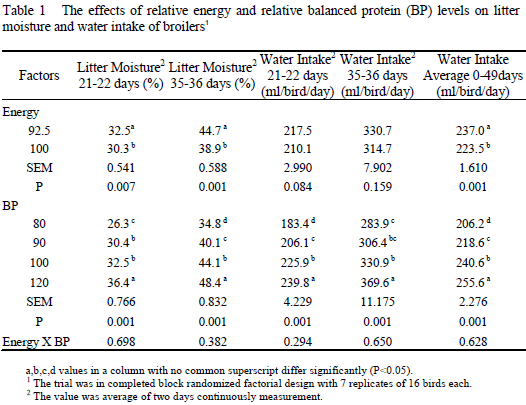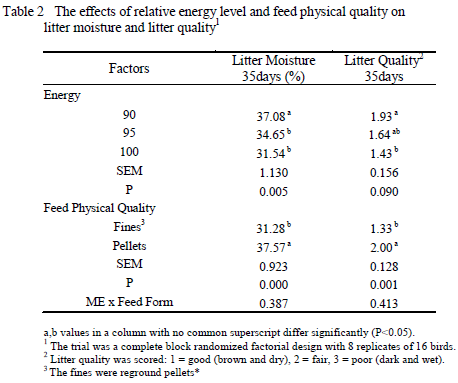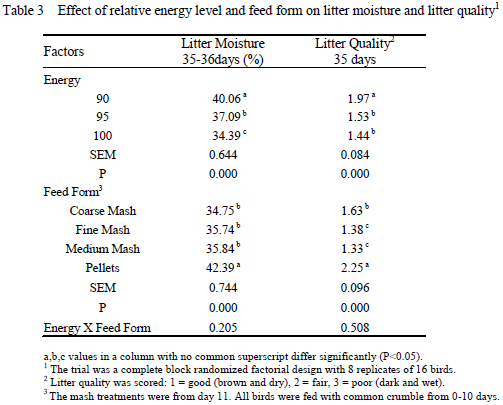



Effects of Nutrition on Water Intake and Litter Moisture on Broiler Chickens
Dietary metabolisable energy, balanced protein, mineral content, feed physical quality, feed form and feed restriction can significantly influence litter moisture, litter quality and/or water intake of broilers, according to K.H. Huang (Aviagen Inc.) and C. Kemp and C. Fisher (Aviagen Ltd). The paper was presented at the Australian Poultry Science Symposium 2001.
Summary
A series of experiments was conducted to investigate the effects of nutrition and feed on litter moisture, litter quality and water intake of broilers. The diets were formulated with reference to Ross Broiler Nutrition Specifications (2007). Nutritional treatments involved dietary metabolisable energy, balanced protein, mineral content, feed physical quality, feed form and feed restriction.
The results showed that increasing dietary energy, reducing dietary balanced protein or reducing mineral levels decreased (P<0.05) litter moisture and water intake and improved litter quality. Feed physical quality and feed form results showed a benefit from using reground pellets or mash feed for reducing litter moisture and improving litter quality. Feed restriction at 10 per cent of ad libitum led to higher litter moisture, poor litter quality and higher water intake, compared to ad libitum.
It was concluded that these various nutritional factors, can significantly influence litter moisture, litter quality and/or water intake of broilers.
Introduction
Litter conditions significantly influence broiler performance and the profitability of broiler production. Litter is defined as the combination of bedding material, excreta, feathers, spilled feed and water. Litter moisture and condition of the excreta are the most important factors determining litter conditions.
Excessive litter moisture may lead to high ammonia emissions, footpad dermatitis, processing downgrades and condemnations (Martland 1985; Kenny et al., 2010). Both footpad lesions and litter condition are part of EU welfare legislative control. High litter moisture alone is widely considered to be the major contributor to footpad dermatitis in the industry.
Amongst many factors affecting litter quality, nutrition could be one of the most important, but inconsistent reports in the literature do not facilitate clear conclusions. Recently some nutritional trials conducted by Aviagen have included the measurement of litter moisture and water intake to further understand how feed and nutrition affect these factors in modern broilers. The results reported here investigated the effect of nutrition and feed on water intake, litter moisture and litter quality of broilers. The effects on biological and economic performance were recorded in all trials but are not reported here. The best litter conditions may not be consistent with the best biological performance.
Effects of Dietary Energy Level
The results of four trials investigating the effects of dietary energy level on water intake and/or litter quality are shown in Tables 1, 2, 3 and 4. The diets were corn-soybean meal base, formulated to Ross Broiler Nutrition Specifications (2007), and pelleted in 3-mm die or fed as mash. The energy levels were 100, 95, 92.5 and 90 per cent, where 100 per cent was equal to Ross 2007 specification, i.e. starter (0 to 10 days), 12.65MJ/kg; grower (11 to 24 days), 13.20MJ/kg; finisher (>25 days), 13.40MJ/kg. All other nutrients were the same as Ross 2007 specification. The decreased energy was achieved by reformulating with higher extracted rice bran and adjusted mostly using maize, soy oil and soybean meal.
All the trials were conducted in a tropical environment in Thailand in pens with rice hulls deep litter.
When dietary energy decreased, litter moisture increased (P<0.05) in all trials (Tables 1, 2, 3, and 4) and daily water intake (0-49 days or 0-42 days) increased (P<0.05) (Tables 1 and 4). Litter quality, scored visually, improved when energy increased (Tables 2 and 3). This could be partly caused by the fibrous ingredient (extracted rice bran) used in the energy dilution.
The reduced litter moisture and litter quality improvement with increased energy could reduce footpad dermatitis as seen by Kenny et al. (2010). However Bilgili et al. (2006) found that low-energy diets significantly reduced the incidence of paw lesions compared with high energy diets. This converse finding is probably a reflection of differences in dietary design; oil was the main ingredient changed to adjust the energy in the study by Bilgili et al.




Effects of Dietary Balanced Protein Level
The results of varying dietary balanced protein (BP) on litter moisture and water intake are shown in Table 1. The trial design was described in the previous paragraph. The BP levels were 80, 90, 100 and 120 per cent, relative to the Ross 2007 specification (=100 per cent), in all growing phases. All other nutrients, such as energy, minerals and vitamins, were the same as Ross 2007 specification.
When BP increased in diets, the litter moisture and water intake increased (P<0.05). Our findings are similar to those of Ferguson et al. (1998).
Effects of Dietary Mineral Levels
The effects of dietary mineral levels on litter moisture and quality, as measured by litter capping, at 26 days are shown in Table 5. The diets were based on wheat and soybean meal. The control diet was formulated to Ross Broiler Nutrition Specifications (2007), and the reduced mineral diet was the same specification as the control except for calcium (Ca), available phosphorus (avP) and sodium (Na), which were as shown in Table 5. All diets were pelleted in 3-mm die with phytase added.
The contribution of Ca, AvP and Na from phytase was included in the calculated levels. The trial was conducted in the Aviagen trial facility in the UK in pens with wood shavings litter.
The reduced mineral diet led to lower litter capping (P=0.053) but had no effect on litter moisture (P=0.273). Excessive dietary mineral intake has been shown to increase excreta moisture and water intake (Johnson and Karunajeewa, 1985). The mineral levels in current trial were considered to be balanced; however, there may be an opportunity to explore lower levels at some growing stages, if litter moisture and quality are problematic.

Effects of Feed Physical Quality and Feed Form
The effects of different feed physical qualities and feed form on litter moisture and litter quality are shown in Tables 2 and 3. The trial design was described above in Section II. For the fines treatment in Table 2 reground pellets were used. In Table 3, the mashes of different particle sizes were obtained by changing the screen and speed of hammer mill and they were not heat-treated.
The results showed that the birds fed with pellets resulted in higher (P<0.05) litter moisture and poorer (P<0.05) litter quality than the fines or mash groups. It is possible that the feed intake on fines and mash was much lower than pellets, resulting in lower water intake (data not shown).
Effects of Feeding Methods
The effects of restricted feeding on litter moisture, litter quality and water intake are shown in Table 4. The trial design was described in section II above. The feeding methods used were ad libitum and a 10 per cent feed restriction applied from day 6.
The feed restriction significantly (P<0.05) increased litter moisture content and decreased litter quality at 35 days, although water intake was not different at week 5 (the week that litter moisture was measured).
It is interesting to note that the average daily water intake for 0 to 42 days was significantly higher on ad libitum than on restricted feeding, an observation which could be related to higher feed intake. The effect of feed restriction leading to higher litter moisture and poorer litter quality has not been described previously to our knowledge. It could be that water intake was stimulated because birds felt unsatisfied during the feed restriction.
Conclusion
Many factors will affect litter moisture in practice, including management and housing (type of litter, temperature, ventilation, stocking density, heating, drinking system), disease and health status (coccidiosis, viral and bacterial disease) and nutrition.
The present results demonstrate that the nutritional factors, such as energy, balanced protein, mineral contents, feed form and feed physical quality, and feed restriction, have a significant influence on litter moisture content and litter quality and/or water intake. Litter moisture significantly contributed to poor litter conditions and footpad dermatitis, which leads to welfare issues. Controlling litter moisture to improve in-house environment is essential to improve broiler performance and nutrition has role to play in terms of improving litter conditions.
References
Bilgili S.F., Alley M.A., Hess J.B. and Nagaraj M. 2006. Journal of Applied Poultry Research, 15:433–441.
Ferguson N.S., Gates R.S., Taraba J.L., Cantor A.H., Pescatore A.J., Ford M.J. and Burnham D.J. 1998. Poultry Science, 77:1481-1487.
Johnson R.J. and Karunajeewa H. 1985. Journal of Nutrition, 115: 1680-1690.
Kenny M., Kemp C. and Fisher, C. 2010. XIII European Poultry Conference, Tours, France 23-27 August 2010.
Martland, M.F. 1985. Avian Pathology, 14:353–364.
Ross Broiler Nutrition Specification. 2007. Aviagen Inc., Huntsville, Alabama, USA
Further Reading
| - | You can view other papers presented at the Australian Poultry Science Symposium 2011 by clicking here. |
May 2011









